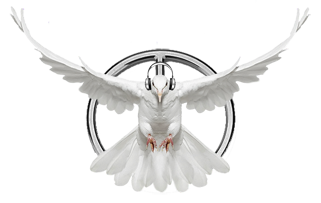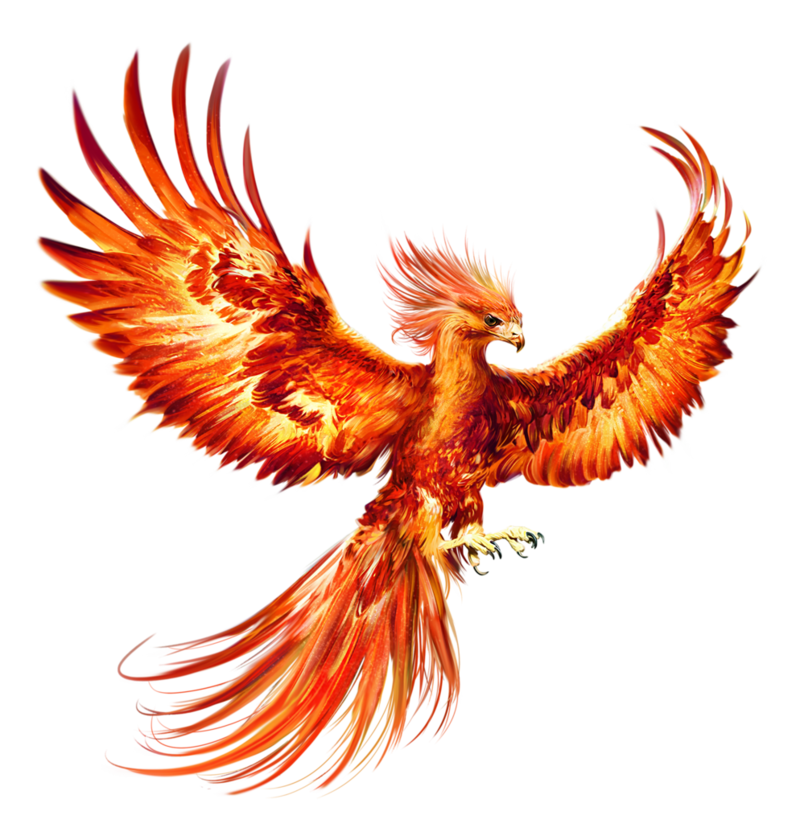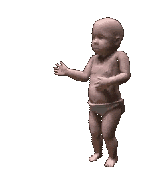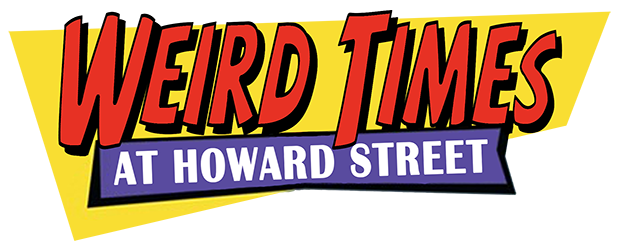
Be weird now.
These are the weird times!
And when the going gets weird, the weird will dance.
We are gathering the tribes together again, for a special late summer edition of the How Weird Street Faire. Located in the reemerging heart of downtown San Francisco, there will be a sensational spectacle that will rival the days of old. Join people in colorful costumes, who have come together to celebrate peace, creativity, and weirdness.
There will be a lot going on! With eight stages of world-class electronic music, spectacular performances, fantastic foods, unique vendors, cannabis experience, visionary art, and inspiring creativity.
“Imagine dancing with everyone you love.”
How Weird is centered at Howard and 2nd Streets, or 37°47’12.4″ N, 122°23’53.7″ W. The faire is located in the SoMa district, the center of the technology industry for the city since the 1990s, and perhaps the world. How Weird attracts many of the area’s innovative technologists and internet pioneers, who are making a profound effect on the world with their ideas and digital tools.
The area around the faire is also home to a large concentration of art galleries and museums. How Weird attracts many types of artists and lovers of art and culture. The faire, the area, and the participants represent the convergence of art and technology, the fusion of creativity and possibilities. How Weird is a place where evolutionary ideas can form, paving the way for fresh perspectives and new ways of viewing the world.
This year, the four entrances to the faire are at Howard and 1st Streets, at Howard and New Montgomery Streets, Folsom and 2nd Streets, and at Mission and 2nd Streets. We strongly recommend taking public transportation to the faire. The How Weird Street Faire is located a short walk from Market Street and the Montgomery BART station, as well as Caltrains Station and many MUNI lines. The new Transbay Terminal is located right next to the faire.
We ask that everyone come to the faire in costume. Come as the You you’ve always wanted to be. Come as an alien, or in styles from the 1990s. Be something colorful and inspiring and weird. Weird is always in style. This year make a point of dressing weirder than before.
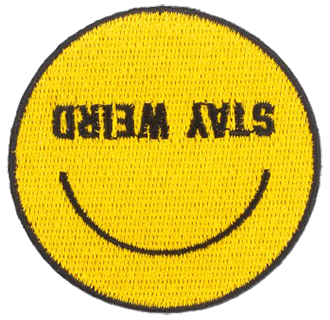
Art Alley will be overflowing with sensational delights this year, in an expanded location on Minna Street. There will be live painting and interactive art and exhibited artwork. Plus there will be local art and craft vendors.
This year Green Alley will be on Tehama Street, featuring educational opportunities and visionary presentations. Green Alley is open to all How Weird Street Faire participants.
The How Weird Street Faire features some of the top stage producers, DJs, and sound systems on the planet. Many different genres of electronic music are represented on the various stages, creating a very diverse music festival. How Weird is an annual reunion of the tribes for electronic music dancers of all sorts, united in their love of dance.
The legendary soundtrack for How Weird 2023 will be provided by diverse Northern California sound collectives featuring a wide range of electronic dance music by local and international artists. This year will feature music stages by Muti Music and Northern Nights, Inorbit and Raindance, Opulent Temple and Opel and Opulent Chill, Temple Nightclub, Pulse SF, Bootie Mashup and Heavy Petting Zoo, the Consortium of Collective Consciousness, and Mountain Lion Hi-Fi.

The How Weird Street Faire is filled with many vendors from around the world selling unique and designer goods. From clothing to art to jewelry and accessories, you can find interesting things and new styles for the the next festival season. How Weird features an unusually diverse shopping experience that you won’t find anywhere else.
And stop by the central Info Booth, to chill and learn about peace. That’s where the Lost & Found will be located, How Weird t-shirts for sale, as well as the answers to all of your faire questions. The Info Booth will be on 2nd Street at Howard, at the center intersection.
Enjoy all that the faire has to offer! You will enjoy discounts and specials and fun activities and many free things at the faire vendors.
We recommend getting Presale Tickets so you save money and save time when you arrive at the separate Presale entrances to the faire.
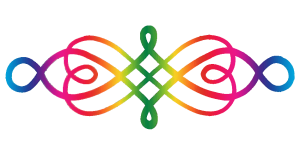
Albert Einstein once said, “No problem can be solved from the same level of consciousness that created it.” So we gather to bring about a change in consciousness. The How Weird Street Faire celebrates acceptance and appreciates diversity. Leave your fear behind.
The How Weird Street Faire is a project of the educational nonprofit World Peace Through Technology Organization, inspiring peace and showing the world what is possible.
.
We started the How Weird theme trip through time with the theme of 1967, which was the “Summer of Love” and first modern festival season. Then we got funky with the 1970s, when disco took over and the world danced. Last year we got weird with it and took on the 1880s and the 1980s. That was the time when recorded music was invented and experienced for the first time (1880s), plus the time when electronic dance music and the technological tools needed to make it were invented, including the personal and laptop computers, the Roland TR-808 drum machine, and Roland’s TB-303 bass synthesizer (1980s). Which brings us to the 1990s, when electronic dance music culture grew and diversified and spread out to every corner of the planet. And that’s when a bunch of freaks started planning for the first How Weird Street Faire. Three of those freaks are still planning the faire, as they have done all 21 years, including Brad Olsen who came up with the actual idea for a faire. How Weird was created back then as a fundraiser for the nonprofit World Peace Through Technology Organization, which it still is today.
This year’s How Weird theme is the fourth and final chapter in our trip through time, this time returning to the source… the 1990s. That was the time that we first discovered electronic dance music and so did many others as the scene grew and prospered. It was the time of our first dance parties and raves, and our first exposure to a truly global culture. San Francisco was an exiciting place in the 90s for music and art and events, from Burning Man to full moon beach raves to gatherings in woods and clubs up and down the coast. It became a hub for many different styles and communities and artists, and provided the opportunity to check out what everyone else was doing. There were many communites that popped up in the mid-1990s, inspired by what was going on around them. They settled into a wide range of available spaces that hosted people from around the world, relatively cheaply and easily. One of those communities was the CCC or Consortium of Collective Consciousness, based in a warehouse on Howard Street in San Francisco. From that community came a vision of peace, a way to bring all the tribes together and find common ground between different types of people. The idea for the How Weird Street Faire was born at the end of the 1990s, with the first faire starting the 2000 festival season.
It wasn’t our intention to keep the vibes of the 90s alive, we were focused more on the future than the past. Yet somehow we managed to do just that. In the 1990s, the “Peace, Love, Unity, Respect” ethos of the early electronic dance music community was a guiding principle. The exposure to new styles of music and fashion made events exciting. There was an abundance of high quality and creativity in the music and art, a result of the large number of artists that used to call San Francisco home. The sense of community was very important, as well as how inviting and accepting people were. These were some of the things that defined the scene that the How Weird Street Faire grew out of, and they are still the core of the How Weird experience. How Weird is one of the few things keeping the spirit of the 90s alive and thriving, and bringing it into the present and the future. You can be a part of history on Sunday October 14, 2023.


The evolution of music festivals from 1967 to How Weird 2020
People have been gathering to enjoy music and dancing for as long as there have been humans. Festivals of all sorts occur around the world. All these gatherings used to be tied to religious events or political events, or time-based events like the solstice. The idea of a festival of art and music for its own sake is a new invention. The seeds of which were the many different countercultural gatherings of the early to mid-1960s.
The first major gathering to bring many of those groups into a cohesive whole was the Trips Festival on January 21–23, 1966. It was the biggest of all the Acid Tests, a three day extravaganza at the Longshoreman’s Hall in San Francisco. Diverse groups of people came to check it out, curious to find out what all the technicolor hype was about. Later that year, an experimental gathering called the Love Pageant Rally took place in San Francisco. It was at that event, on October 6, 1966, that the concept of a Human Be-In was formed. It was envisioned by Michael Bowen and Alan Cohen as a way to bring all the different tribes of countercultures together. They wanted to use the event to raise people’s consciousness, and spread waves of peace and love around the world at a time when it was much needed.
The Gathering of the Tribes for a Human Be-In took place on January 14, 1967 in Golden Gate Park of San Francisco. The event did bring all the tribes together, to enjoy each other’s company and soak in the music, art, talks, and prayers that happened that day. So many people came, that it created a sense of destiny being fulfilled. The Human Be-In was the prototype of the modern music festival that we enjoy today. Before that, groups of rock bands had never performed together outdoors in a festival environment. It was also the beginning of the fabled Summer of Love, the first “festival season” of modern times.
Soon there were Be-In’s in every major city, joined by Love-In’s and weekend concerts, all growing in popularity. On June 10-11, 1967, the KFRC Fantasy Fair and Magic Mountain Music Festival at the Mount Tamalpais Amphitheatre molded the concept into more of the shape we know today. It featured a full line-up of psychedelic rock bands, blues artists, and performers, and it called itself a “music festival”. The cultural phenomenon was refined further two weeks later at the Monterey Pop Festival on June 16–18, 1967. Here the festival structure was exposed to a mainstream audience, and they loved it. The summer of 1967 was filled with many festivals, gatherings, concerts, and happenings. These would continue year after year, reaching a peak at Woodstock in 1969. The idea of a festival season spread rapidly, and by 1970 there were music festivals everywhere. Then came the discos that brought dancing to the mainstream.
The spectacle of the psychedelic dance club was given a slick makeover in the 1970s, and brought to cities and towns around the world. Disco was the awkward teen years of dance culture development, lacking in creativity what it made up for with enthusiasm and popularity. Suddenly, dance culture became mainstream, and then a parody of itself. The eternal longing to dance in community was manifest in weird ways during the 1970s, laying the foundation for what would come.
THE AGE OF ELECTRONIC MUSIC
Although there are examples of electronic music dating back to the introduction of electricity, the electronic music that we have today started in the 1980s. Two inventions led to the rise of electronic dance music, the Roland’s TR-808 and 909 drum machine and Roland’s TB-303 bass synthesizer. These instruments allowed a single music producer to become an entire band. The Roland TR-808 Rhythm Composer was manufactured between 1980 and 1983. It was one of the earliest drum machines that allowed users to program their own rhythms instead of using preset patterns. When it was introduced, the 808 received bad reviews for its unrealistic drum sounds and was a commercial failure. It was replaced in 1984 by the TR-909 drum machine, the first Roland drum machine to use samples. The Roland TB-303 Bass Line was a bass synthesizer released in 1981, however it was a commercial failure as well and was discontinued in 1984. Cheap second-hand 808, 909, and 303 units were adopted by early electronic musicians, and became a foundation of electronic dance music.
We pay tribute to the pioneers that created a new music and lifestyle that went on to become the most widespread culture in the world.
The birth of Electro Music
Sythesizers were changing the music of the 1970s, led by the innovations of Moog and the accessibility of electronic synthesizers. Early adaptors like Kraftwerk, Giorgio Moroder, and Yellow Magic Orchestra created music that paved the way for later electronica. Afrika Boombaataa and the Soulsonic Force popularized the use of the 808, creating a style of music that would later be called Electro, exemplified by the 1982 classic electro-funk song “Planet Rock”.
The birth of House Music
House Music is a genre of electronic dance music that was created by club DJs and music producers in Chicago in the early 1980s. House Music is characterized by repetitive 4/4 beats, rhythms provided by drum machines, off-beat hi-hat cymbals, and synthesized basslines. The music displays several characteristics similar to disco music, which preceded and influenced it, but was more electronic and minimalistic.
In 1977, Frankie Knuckles left New York and his resident DJ gig at the Paradise Garage, and moved to Chicago where a new club was opening called the Warehouse. This is where Knuckles created his signature sound and style, described as ”a wide cross-section of music,” including influences from disco classics, weird indie-label soul curiosities, the occasional rock track, European synth-disco, and all manner of rarities. Knuckles left the Warehouse in November 1982, and opened a new club called the Power Plant a few months later. In 1983, a young DJ from Detroit named Derrick May, sold Frankie a Roland TR-909 drum machine to further enhance his mixes. The combination of the drum machine pulse with an overlay of cult disco classics defined the sound of early Chicago House Music. Ron Hardy was another early pioneer of House Music as the DJ of the influencial Music Box club in Chicago.
In 1985, the first hit House Music dance song came from Chicago’s J.M. Silk, titled “Music Is the Key”. The new style of music was popular in Chicago’s clubs and party spaces, but it only reached the mainstream when it arrived in England in 1986. In January 1987, J.M. Silk’s “Jack Your Body” went to Number One in the UK charts, the first electronic dance song to top any charts. “I remember being interviewed by a journalist in 1986,” explains Frankie Knuckles. “And I remember telling her this music’s gonna be around for a while. It’s gonna take it a long time for it to get to where it needs to be at, but it’ll be around for a long time.” And it’s still going strong today.
The term “House Music” came from a sign in a Chicago window, which Frankie Knuckles saw while driving by in Chicago’s South Side. The sign said “We play house music.” One of the people with him joked, “you know that’s the kind of music you play down at the Warehouse!”. South-Side Chicago DJ Leonard “Remix” Roy, in self-published statements, claims he put that sign up because it was where he played music that one might find in one’s home; in this case it referred to his mother’s soul and disco records, which he worked into his sets.
The birth of Techno Music
Three teenagers who met at Belleville High School in Detroit would change music forever. Derrick May, Kevin Saunderson, and Juan Atkins, known as the “Belleville Three”, created the genre of music we call Techno. Inspired by European electronic sounds, African-American dance music, and the shows of Detroit radio DJ The Electriyfing Mojo, the three began DJing at parties and clubs. They played music that was futuristic and emotional, combining traditional melodies with electonic beats.
Juan Atkins was the first of the Belleville Three to get a synthesizer, a Korg MS-10, which he began recording with cassette decks and a mixer for overdubs. “When I first heard synthesizers dropped on records it was great, like UFOs landing on records, so I got one,” explains Atkins. He and Derrick May started DJing together as Deep Space Soundworks, spreading the new music throughout Detroit in the early 1980s.
“It’s important to say that all of us, together, had this driving force to create what we did. But none of us knew this would be ground-breaking or revolutionary. We had no idea what we did would change the world,” Derrick May recalls. May’s early recordings as Rhythim is Rhythim and Mayday spread around the world, with classic club hits like “The Dance” and “Strings of Life” defining the Techno sound. May describes his music as “high-tech soul”.
The Second Summer of Love – The birth of global dance music culture
House and Techno Music had only limited success in America, but it became very popular overseas, creating a new style of clubbing and culture. In the summer of 1987, a group of English DJs traveled to the Mediterranean island of Ibiza and were turned on to House and Techno, thanks to DJ Alfredo of the open-air club Amnesia. They brought the new style of dance music back to England, where it became a hit.
The Second Summer of Love was the name given to the period of 1988-1989 in the UK, during the rise of House Music and the explosion of raves and dance music culture. The new style intially heard at nightclubs, including Shoom (run by Danny Rampling), Future (organised by Paul Oakenfold), Trip (run by Nicky Holloway), and the Hacienda (run by Mike Pickering and Graeme Park). These DJs were inspired to start the clubs after holidaying in Ibiza in the summer of 1987. The culture soon spread to outdoor gatherings and warehouse parties, and soon became mainstream throughout Europe. Before long, there were festivals around the world, featuring the new music and culture.
The new dance music culture reaches San Francisco in the 1990s
The spectacular immersive experiences that were becoming mainstream in Europe were destined to reach San Francisco, a city famous for its groundbreaking events. And it did in 1991, in a big way. People came from all over the world, including DJs and event promoters and dancers of all types. The culture took hold on the local youth and the rest is history.
In 1991, the Wicked Crew brought the new UK underground style to America, which helped give birth to the west coast’s early rave scene. UK DJs Jenö, Thomas, Markie, and Garth moved to San Francisco, and were staples of the parties throughout the 90s. Jenö played How Weird last year, at the Drift in Time stage by Raindance and Inorbit Productions, his fourth time playing the faire.
There were also massive commercial raves in the early 90s, starting with the Toon Town parties in 1991. And there were also experimental parties in the 90s, and one-off club nights, and a wide range of outdoor events. Perhaps the weirdest of all the early 90s parties was Mr. Floppy’s Flop House, a major influence on the CCC and early psytrance.
By the mid-90s, San Francisco was a major hub for electronic dance music events. The warehouses and clubs were filled with events from a wide variety of sound collectives, bringing the dance inside and outside. Some of the groups from the mid-90s that were active in San Francisco include the CCC (who are producing a stage again this year), Sunset (who have produced stages at How Weird), Come-Unity (who produced a stage at How Weird), S.P.A.Z. (who c0-produced a stage at How Weird), Friends & Family, Funky Tekno Tribe, Spundae, Space Children, A Rave Called Sharon, Bulletproof, the Gathering, and many others. It was an exciting time.
The San Francisco sound collectives brought the dance scene to Burning Man starting in 1991, and other festivals of every kind. Artists from across the globe wanted to come and be a part of it all. It was a innovative time, when everything was new and being created in real time with each gathering. The culture spread rapidly, as another mid-90s innovation, the World Wide Web, became widespread. There was an innocence to that time, the culture was unexploited and still very alternative here in the USA. Those experiences changed our lives, and lay the foundation for the culture we have today.
The birth of How Weird
As it grew, electronic dance music culture diversified and branched into different genres, becoming specialized tribes with similar cultures. In 1995, one of these genres, psytrance music, took root in San Francisco and embraced the inspirational history of experimental culture that had taken place there. Beginning with a group called the Consortium of Collective Consciousness (CCC), some truly transformational gatherings were created. From this tribe, came the How Weird Street Faire. The faire evolved into a way to bring all the different tribes of electronic dance music together, and allow them to experience each others cultures. For one day it would become one big diverse family. It is a way of creating peace within our own community, and being an inspiration to others.
Now, 20 years later, the How Weird Street Faire has become the official start to San Francisco’s famous festival season. The faire is the modern equivalent to the Human Be-In, representing the next generation of experimental gatherings. How Weird fuses many types of events together to make a unique blend. There are elements of electronic music festivals and rock festivals, art festivals and craft festivals, circuses and performances, Burning Man and regional events, clubs and raves, cultural and neighborhood street fairs, peace and activist activities, community events and spiritual services, and just plain weirdness. Combined they represent all the different countercultures of today. How Weird brings them together to celebrate our similarities and appreciate our differences. The public is invited to join in the experience, as everyone is weird in some way. Let’s take gatherings, and ourselves, further.
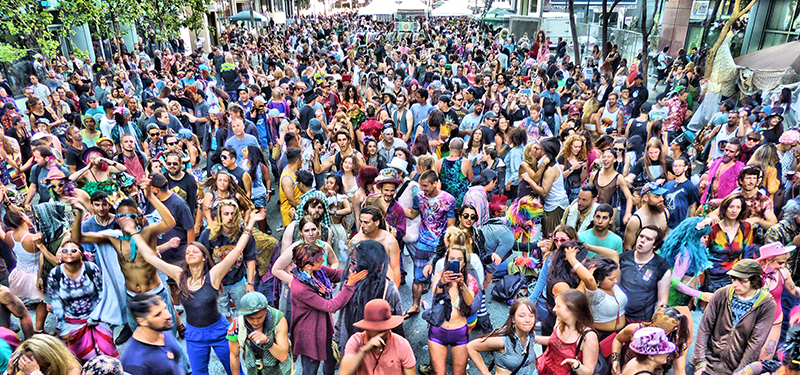
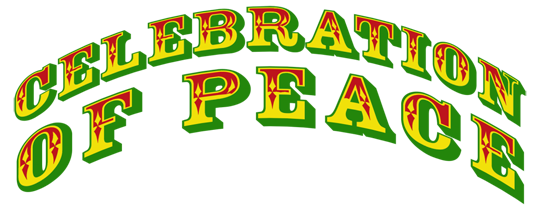 THE COMPONENTS OF A PEACE EVENT
THE COMPONENTS OF A PEACE EVENT
MUSIC
Music is a bridge, connecting everyone. Music is the ideal medium for crossing barriers, and uniting diverse people. Music knows no boundaries. More than any other form of communication, music is able to transcend differences between people. Music has the power to change us physically, directly affecting the emotions and the chemical balance of the body. Music inspires us and takes us to other places. Music can lift our spirits and increase our creativity. Music can heal people. UN Secretary General Ban Ki Moon said recently, “There are no languages required in the musical world. In this era of instability and intolerance we need to promote better understanding through the power of music.”
Electronic music plays a key role in the How Weird Street Faire, and one of the reasons why the faire attracts people from all over the world. Electronic music is the most diverse and globally listened to music in human history. Every culture and every country has DJs playing and creating music, and communities forming wherever people dance together. In some places it is the mainstream culture, in others it is alternative or underground, but electronic music is present everywhere on the planet.
How Weird features the full spectrum of electronic music styles, bringing different communities together to connect them to each other and encourage cooperation and mutual appreciation. This gathering of the tribes at How Weird creates a unique music festival that is always full of surprises. Faire participants are encouraged to see and experience all the different music stages, and try something new. Great care has been taken by each stage to create a high quality environment to enjoy the music and dancing, and have a maximum amount of fun. Electronic music is a good choice of music for helping to create peace, as represented by the cultural motto of “peace, love, unity, and respect”.
DANCING
Dance is a fun activity that everyone can participate in, and find common ground and similar interest with anyone else. It is a very effective way of connecting with others. Dance and music are powerful ways to reach a deep meditative state, used for thousands of years with much success. A meditative state is helpful for bringing inner peace, and building the foundations for lasting peace with others. Dancing in a group also synchronizes the individuals on a collective level, enabling deeper understanding and acceptance of others, and forming coherence among the group. In spite of our differences, when we dance to the same beat, we become one.
A Cambridge University study published in the Psychology of Music journal in 2012 found that “interacting with others through music makes us more emotionally attuned to other people,” resulting in an increase of compassion and understanding of others. Another article in the American Psychological Association journal Emotion in 2011, called “Synchrony and the Social Tuning of Compassion” described how “synchronized movement evokes compassion” in groups of people. Science is noticing the same things that we did, that dancing together creates very deep connections and increases empathy, which leads to peace. As Dr. Simon Baron-Cohen, professor of developmental psychopathology at Cambridge University, explained, “Any problem immersed in empathy becomes soluble.”
Cultures all over the planet have enjoyed dance since before the written word, it is a universal expression of life. As Nelson Mandela once said, “It is music and dancing that makes me at peace with the world.”
VISUAL ART
Visual art, like music and dance, is a form of communication that bridges separations, and speaks directly to the heart and soul. Art can lead to greater understanding and appreciation of others. How Weird showcases many kinds of expression, including visionary art. We found that being surrounded by visionary art helps to recreate those states of awareness, and lay the foundation for deeper connections and understanding to take place. Music, dance, and art have always been recognized as having powerful effects on human consciousness, and being a fundamental part of our existence.
BECOMING MORE AWARE
The How Weird Street Faire tries to raise people’s consciousness through music, art, dancing, and ideas. By viewing the world from a wider perspective, the connections between us become more apparent, as well as our common interests. By raising our level of awareness and understanding, we make it easier to live in peace, to develop connections between people, and to find solutions to the many problems facing humanity at this time. As Albert Einstein explained, “No problem can be solved from the same level of consciousness that created it.”
DIVERSITY
The How Weird Street Faire celebrates extreme diversity and individual expression. Those attending and participating in the faire are a vast multitude from all over the planet, and perhaps other planets as well, representing a very unique and interesting mix of sentient beings. All of them potentially finding common ground and connecting with each other and new communities. Every continent on Earth, with the exception of Antarctica, is represented at the faire. There are babies and small children to young adults to elderly, and all in between. There are very wealthy attendants, and struggling students and artists. There are people of different politics and religions and perspectives, that have chosen to attend the same faire and enjoy the same activities. The extreme diversity of people at How Weird is testament to the universal appeal of inspiring art and music, and the desire of all people to celebrate peace. That deep connections are made, and a collective cohesion is formed, is proof that these elements can unite even the most extreme differences.
The faire is open to people of all ages, all backgrounds, and all points of view. Everyone is encouraged to be accepting of others, and to appreciate the differences between us. One faire participant explained why he liked the faire, “Instead of trying to bring us all into one line, we all get to enjoy what makes us different.” A visitor from the United Kingdom last year exclaimed, “I loved how expressive and accepting everyone was.” Strategic Retreat blog wrote, “Weird it was. The weirdness was only outshone by how inclusive and fun it was.”
AN OPEN MIND (or as we say “being weird”)
We chose the name “How Weird” as a play on Howard Street, the street where the faire took place. At first, we thought everyone would see the play on words, and didn’t really appreciate our own weirdness. Over the years, we grew to embrace being weird. We found that celebrating weirdness encouraged people to freely express themselves, and readily accept others. If everyone is weird, all viewpoints are equally valid, and everyone has an opportunity to be appreciated. Suddenly, the person who was an outsider is now a valuable part of the community. Differences between people become so great, that they become something interesting and amusing rather than dividing. Similarities that would usually remain elusive are brought out, enabling connections where none could have been imagined before. Being weird means doing things differently, and seeing the world in a unique way. Being weird enables us to step outside of preconceived notions and stereotypes, and think things we normally wouldn’t think. Having a festival of weirdness is an excellent way to open people’s minds, and prepare them to accept others no matter how different they are.
We weren’t the only ones who noticed these traits of weirdness. Being weird used to evoke emotions of fear and intolerance. In our modern world of rapid changes and extreme complexity, weird has become a desirable attribute, especially in the technology industry, which continues to play a major role in How Weird’s regional environment and immediate neighborhood. Weird has become associated with being creative and innovative. Thinking in a weird way has become the popular key to “stepping outside of the box”, as we try to solve the planet’s problems, as well as our own. Being weird somehow plays a part in creating an effective peace event. Perhaps, like clowns and jesters, being weird gives people permission to tear down preconceptions and rewrite all the rules, placing them in a position to find new ways of living and interacting with others. Being weird encourages people to open their mind and accept new perspectives. Being weird allows people the opportunity to be outside of their usual way of doing and seeing things, and try a fresh approach. Plus being weird is fun.
Having people arrive in strange and colorful costumes reinforces the element of weirdness and unexpectedness, that anything is possible. At first, we just liked wearing costumes. But soon we noticed that it is an excellent way to encourage individual expression and acceptance of others. Costumes enable people to be themselves. Individual costumes break down the associations with groups or ideologies, and allow people to appreciate others based solely on their creativity and interests.
How Weird inspires peace by bringing people together and allowing them to experience a place where everyone is accepted no matter what their background is. At How Weird, everyone is appreciated for having a unique perspective that is valuable to the whole. We encourage having an open mind by embracing the weirdness within us all, the things we do differently, the things that make us unique. What political or religious affiliation someone has makes little difference when they are in an outrageous costume, dancing in the middle of the street. How Weird provides a place where people can be understood by their similar passions. At How Weird, people are surrounded by unexpected opportunities to connect with others and find common ground. Despite the extreme diversity at the faire, it is all one community.
The extreme participation of the faire goers, especially the costumes and dancing, encourages a level of acceptance and appreciation rarely seen at a public event. It is an environment that fully embraces inclusion and appreciation. By accepting others’ perspectives, we increase our capacity for empathy and understanding. Allowing yourself and others to be weird can be an important lesson in peace. In a place where everyone is weird, then every way of seeing things becomes equal, and differences are more appreciated. This leads to collective empathy and understanding. If this level of respect for each other was the standard way of dealing with each other, there would be no more wars.
FUN
The faire is a lot of fun. Peace is fun. Fun makes everything better. Having a positive attitude helps to connect with others and appreciate them. Plus it’s hard to fight when you’re having fun. Fun often results in smiles, which are very contagious. Smiles help to make people happy, even at a distance. And happy people are at peace.
Buckminister Fuller noticed that to create change, you need to built something new that makes the old way obsolete. We feel that in order to create a new world that is sustainable and at peace, we need to build something that is better and more fun. Peace is badly needed now, so that we may thrive on this planet and coexist with each other. It is through music, art, and the imagination that peace is always possible.
